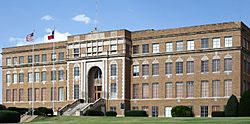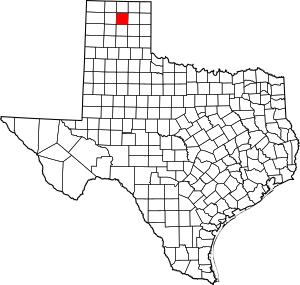Hutchinson County, Texas facts for kids
Quick facts for kids
Hutchinson County
|
|
|---|---|

The Hutchinson County Courthouse in Stinnett
|
|

Location within the U.S. state of Texas
|
|
 Texas's location within the U.S. |
|
| Country | |
| State | |
| Founded | 1901 |
| Seat | Stinnett |
| Largest city | Borger |
| Area | |
| • Total | 895 sq mi (2,320 km2) |
| • Land | 887 sq mi (2,300 km2) |
| • Water | 7.5 sq mi (19 km2) 0.8% |
| Population
(2020)
|
|
| • Total | 20,617 |
| • Density | 23.036/sq mi (8.894/km2) |
| Time zone | UTC−6 (Central) |
| • Summer (DST) | UTC−5 (CDT) |
| Congressional district | 13th |
Hutchinson County is a county in the state of Texas. In 2020, about 20,617 people lived there. Its main town, called the county seat, is Stinnett. The county was first created in 1876, but it didn't officially start working until 1901. It is named after Andrew Hutchinson, who was an important lawyer in early Texas.
Hutchinson County is part of the Borger, Texas, area. This area is also included in the larger Amarillo-Borger region. The county is located in the northern part of the Texas Panhandle, which is the square-shaped section of Texas. You can learn about the county's past at the Hutchinson County Historical Museum in downtown Borger. This museum is also known as Boomtown Revisited. Hutchinson County has more ghost towns than any other county in the Texas Panhandle.
History
Native Americans
Many old tools and signs of the Antelope Creek Indian culture can be found along the Canadian River valley in Hutchinson County. Experts have discovered a large area of Alibates flint, about 1,300 acres (5.3 km²), that was used as a quarry. A quarry is a place where people dig up stone. This flint was used to make tools. Native American groups like the nomadic Plains Apache, Comanche, Arapaho, Kiowa, and Cheyenne also camped in this area.
A trading company called Bent, St. Vrain and Company built a trading post here to trade with the Native Americans. This post was known as Fort Adobe. Three years later, traders blew it up because of attacks from Native Americans. The remains of the fort became known as Adobe Walls.
The First Battle of Adobe Walls happened in 1864. General James H. Carleton sent Colonel Kit Carson and his soldiers to the area. They wanted to stop the repeated Native American attacks. Carson and his few hundred cavalry soldiers were greatly outnumbered by the Kiowa and Comanche warriors. They had to retreat.
The Second Battle of Adobe Walls took place in 1874. A group of buffalo hunters tried to rebuild Fort Adobe. The Comanches, Cheyenne, Arapaho, and Kiowa saw this new fort and the hunting of buffalo as a threat to their way of life. A Comanche spiritual leader named Isa-tai told them they would win and that white men's bullets would not harm them. Quanah Parker led several hundred warriors in an attack on the fort. However, the buffalo hunters were able to make the Native Americans retreat.
Early Explorations
In 1541, an expedition led by Francisco Vásquez de Coronado traveled through this area. They were searching for a mythical golden city called Quivira on the Great Plains. Another Spanish explorer, Juan de Oñate, passed through in 1601 on his way to Kansas.
Buffalo hunters and traders from New Mexico, called Comanchero, hunted and traded here until the 1870s. The first Anglo-American group to come through the county was led by Stephen H. Long in August 1820. He mistakenly thought the Canadian River was the Red River. Josiah Gregg brought his Santa Fe trading caravan through in March 1840. In December 1858, Lt. Edward Beale and 100 men built a military road through the county. This was the first federally funded road in the American Southwest. It went from Fort Smith, Arkansas, to Los Angeles and was called the Beale Wagon Road.
Early Ranch Entrepreneurs
In November 1876, Thomas Sherman Bugbee from Kansas started the Quarter Circle T Ranch. The Scissors Ranch was begun in 1878 by William E. Anderson at the Adobe Walls site. The ranch was named after its brand, which looked like a pair of scissors.
Richard E. McNalty from Colorado moved to Texas and started the Turkey Track Ranch. He sold it to Charles Wood and Jack Snider in 1881. James M. Coburn, who was born in Scotland, created the Hansford Land and Cattle Company. Coburn bought the Quarter Circle T Ranch and Scissors Ranch in 1882. He then bought the Turkey Track Ranch in 1883.
County Established
Hutchinson County was officially created in 1876. However, it wasn't fully organized until 1901. At that time, Plemons became the first county seat, which is the main town for the county government. For the next 40 years, ranching was the main way people made a living in the county. Growing crops slowly became more common.
The Panhandle oilfield was found in the 1920s. On June 1, 1923, the Sanford No. 1 J. C. Whittington well in southwestern Hutchinson County struck oil at a depth of 3,077 feet (938 m). New towns quickly grew because of this oil boom. The population jumped from 721 people in 1920 to 14,848 in 1930. By 1990, over 526 million barrels of oil had been taken from Hutchinson County lands since 1923.
Stinnett became the new county seat after a special election on September 18, 1926.
Geography
The county has a total area of 895 square miles (2,318 km²). Most of this, 887 square miles (2,297 km²), is land. The remaining 7.5 square miles (19 km²), or 0.8%, is covered by water.
Major Highways
Neighboring Counties
- Hansford County (north)
- Roberts County (east)
- Carson County (south)
- Moore County (west)
- Potter County (southwest)
- Gray County (southeast)
- Sherman County (northwest)
- Ochiltree County (northeast)
National Protected Area
- Lake Meredith National Recreation Area (part)
Population Information
| Historical population | |||
|---|---|---|---|
| Census | Pop. | %± | |
| 1880 | 50 | — | |
| 1890 | 58 | 16.0% | |
| 1900 | 303 | 422.4% | |
| 1910 | 892 | 194.4% | |
| 1920 | 721 | −19.2% | |
| 1930 | 14,848 | 1,959.4% | |
| 1940 | 19,069 | 28.4% | |
| 1950 | 31,580 | 65.6% | |
| 1960 | 34,419 | 9.0% | |
| 1970 | 24,443 | −29.0% | |
| 1980 | 26,304 | 7.6% | |
| 1990 | 25,689 | −2.3% | |
| 2000 | 23,857 | −7.1% | |
| 2010 | 22,150 | −7.2% | |
| 2020 | 20,617 | −6.9% | |
| U.S. Decennial Census 1850–2010 2010 2020 |
|||
The population of Hutchinson County has changed a lot over the years. It grew very quickly in the 1930s because of the oil boom. Since then, the population has gone up and down. In 2020, there were 20,617 people living in the county.
| Race / Ethnicity (NH = Non-Hispanic) | Pop 2000 | Pop 2010 | Pop 2020 | % 2000 | % 2010 | % 2020 |
|---|---|---|---|---|---|---|
| White alone (NH) | 19,104 | 16,482 | 13,783 | 80.08% | 74.41% | 66.85% |
| Black or African American alone (NH) | 563 | 512 | 416 | 2.36% | 2.31% | 2.02% |
| Native American or Alaska Native alone (NH) | 289 | 300 | 273 | 1.21% | 1.35% | 1.32% |
| Asian alone (NH) | 83 | 91 | 105 | 0.35% | 0.41% | 0.51% |
| Pacific Islander alone (NH) | 4 | 3 | 2 | 0.02% | 0.01% | 0.01% |
| Other race alone (NH) | 5 | 23 | 52 | 0.02% | 0.10% | 0.25% |
| Mixed race or Multiracial (NH) | 303 | 353 | 1,025 | 1.27% | 1.59% | 4.97% |
| Hispanic or Latino (any race) | 3,506 | 4,386 | 4,961 | 14.70% | 19.80% | 24.06% |
| Total | 23,857 | 22,150 | 20,617 | 100.00% | 100.00% | 100.00% |
Communities
Cities
- Borger
- Fritch (a small part is in Moore County)
- Stinnett (the county seat)
Town
Census-Designated Place
Unincorporated Community
Ghost Towns
Education
Here are the school districts in Hutchinson County:
- Borger Independent School District
- Plemons-Stinnett-Phillips Consolidated Independent School District
- Pringle-Morse Consolidated Independent School District
- Sanford-Fritch Independent School District
- Spearman Independent School District
All of Hutchinson County and the Borger ISD area are part of the attendance district for Frank Phillips College. This is a community college that used to be called Borger Junior College District.
The Spring Creek Independent School District joined with Borger ISD on July 1, 2024.
Notable People
- Donny Anderson, a Green Bay Packers football player
- Mary Castle, an actress
- Billy Dixon, an Indian scout, Medal of Honor winner, and sheriff of Hutchinson County
- G. William Miller, a former United States Secretary of the Treasury and chairman of the Federal Reserve Board
- Ron White, a comedian, known for his work with the Blue Collar Comedy Tour
See also
 In Spanish: Condado de Hutchinson (Texas) para niños
In Spanish: Condado de Hutchinson (Texas) para niños

